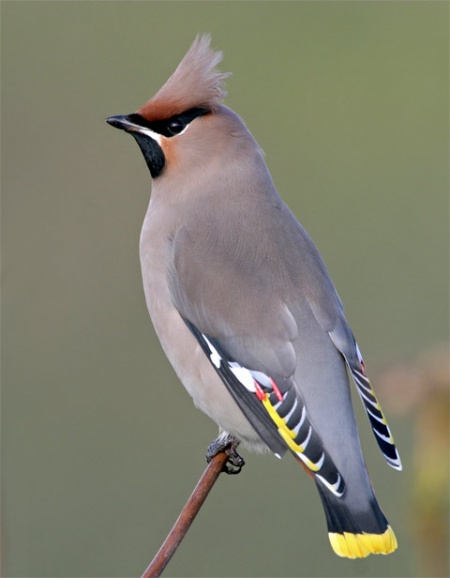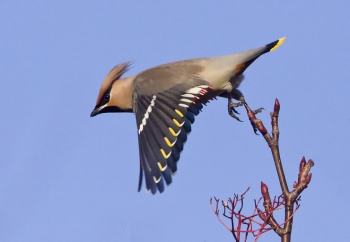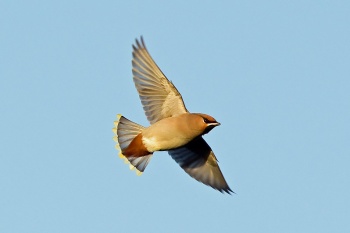(Image first. Picture size and placement, Dictionary link. References updated) |
(Additional flight picture. References updated) |
||
| Line 12: | Line 12: | ||
Breeds from [[Alaska]], [[Yukon]], [[Mackenzie]], [[Saskatchewan]], and [[Manitoba]] south to central [[Washington]], northern [[Idaho]], and northwestern [[Montana]]. Wanders irregularly farther south and east during winter. | Breeds from [[Alaska]], [[Yukon]], [[Mackenzie]], [[Saskatchewan]], and [[Manitoba]] south to central [[Washington]], northern [[Idaho]], and northwestern [[Montana]]. Wanders irregularly farther south and east during winter. | ||
==Taxonomy== | ==Taxonomy== | ||
| + | [[Image:1D4 3621bf.jpg|thumb|350px|right|Photo by {{user|Sandpiper|Sandpiper}}<br />Marston, [[Lincolnshire]], UK, November 2012]] | ||
====Subspecies==== | ====Subspecies==== | ||
There are 3 subspecies<sup>[[#References|[1]]]</sup>: | There are 3 subspecies<sup>[[#References|[1]]]</sup>: | ||
| Line 33: | Line 34: | ||
''[[Media:Bombycilla garrulus (song).mp3|Listen in an external program]]'' | ''[[Media:Bombycilla garrulus (song).mp3|Listen in an external program]]'' | ||
==References== | ==References== | ||
| − | #{{Ref- | + | #{{Ref-Clements6thOct12}} |
{{ref}} | {{ref}} | ||
==External Links== | ==External Links== | ||
Revision as of 15:05, 4 December 2012
- Bombycilla garrulus
Identification
7 1/2 -8 1/2" (19-22 cm)
A sleek, gray-brown, crested bird. Similar to Cedar Waxwing but larger, grayer, and with conspicuous white wing patches and most importantly rusty (not white) undertail coverts.
Distribution
Old World Range
Breeds rather sparsely in north-central Sweden, and the northern half of Finland, and more commonly across northern Russia between about 60oS and 66oN.
A partial migrant with many birds remaining in breeding range through the winter but makes irregular invasions further south and south-west. Normal winter range extends throughout Scandinavia, Germany and Netherlands in the west and south to the Black Sea in the east. During irruption years variable numbers reach Britain, mainly on the east coast from Shetland to Kent, usually in October-November and staying until February-March, rarely later although summering pairs have occurred.
New World Range
Breeds from Alaska, Yukon, Mackenzie, Saskatchewan, and Manitoba south to central Washington, northern Idaho, and northwestern Montana. Wanders irregularly farther south and east during winter.
Taxonomy
Subspecies
There are 3 subspecies[1]:
- B. g. pallidiceps:
- North-western North America; highly nomadic in winter
- B. g. garrulus:
- B. g. centralasiae:
Habitat
Breeds in the taiga, usually in pine or spruce, sometimes mixed with birch, rarely in mountains but found in foothills and lowlands. In autumn seeks berry-bearing trees and bushes and occurs in gardens, parks and along hedgerows on farmland and on roadsides. In Britain preferred berries are hawthorn and cotoneaster.
Behaviour
Breeding
They nest in a pine tree and the nests are lined with fine grass, moss, and down. 4 to 6 pale blue with black spots and lines eggs are laid. They are incubated for 14 days; the young fledge about 13 to 15 days later.
Diet
The diet includes berries supplemented by insects.
Vocalisation
High-pitched, lisping seeee, harsher and more grating than call of Cedar Waxwing.
<flashmp3>Bombycilla garrulus (song).mp3</flashmp3>
Listen in an external program
References
- Clements, J. F., T. S. Schulenberg, M. J. Iliff, B.L. Sullivan, C. L. Wood, and D. Roberson. 2012. The eBird/Clements Checklist of Birds of the World. 6th ed., with updates to October 2012. Ithaca: Cornell Univ. Press. ISBN 978-0801445019. Spreadsheet available at http://www.birds.cornell.edu/clementschecklist/downloadable-clements-checklist
Recommended Citation
- BirdForum Opus contributors. (2024) Bohemian Waxwing. In: BirdForum, the forum for wild birds and birding. Retrieved 19 April 2024 from https://www.birdforum.net/opus/Bohemian_Waxwing
External Links






